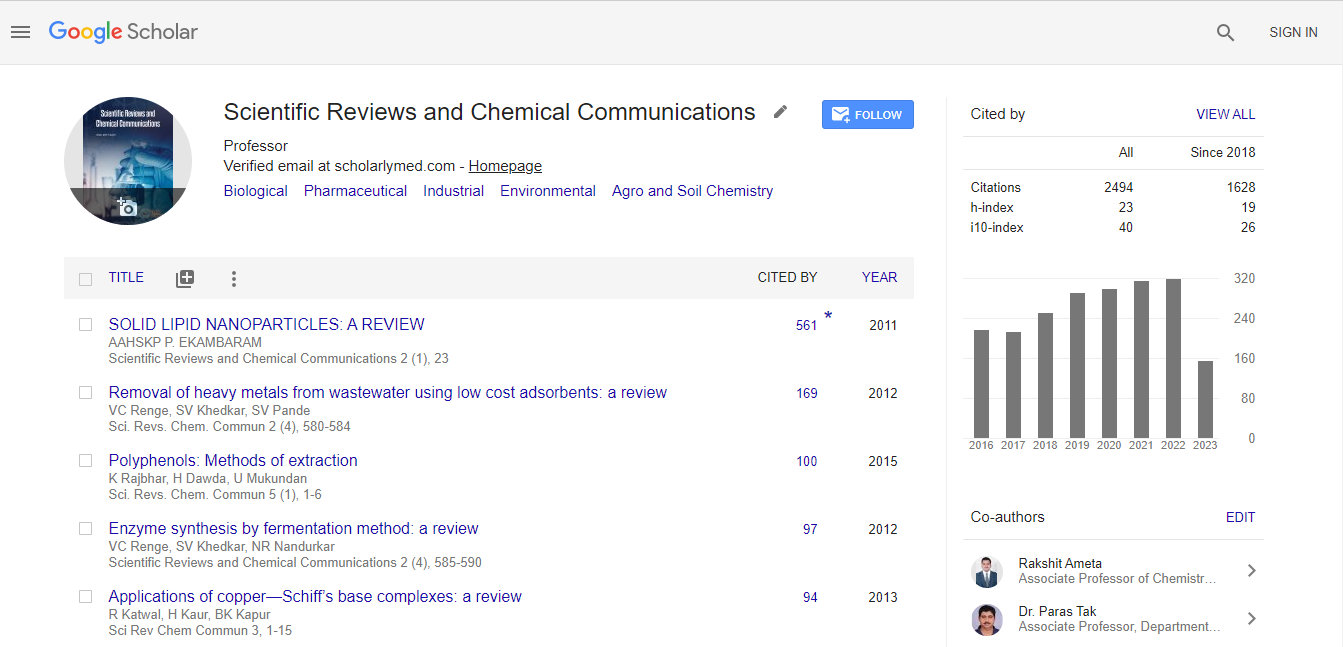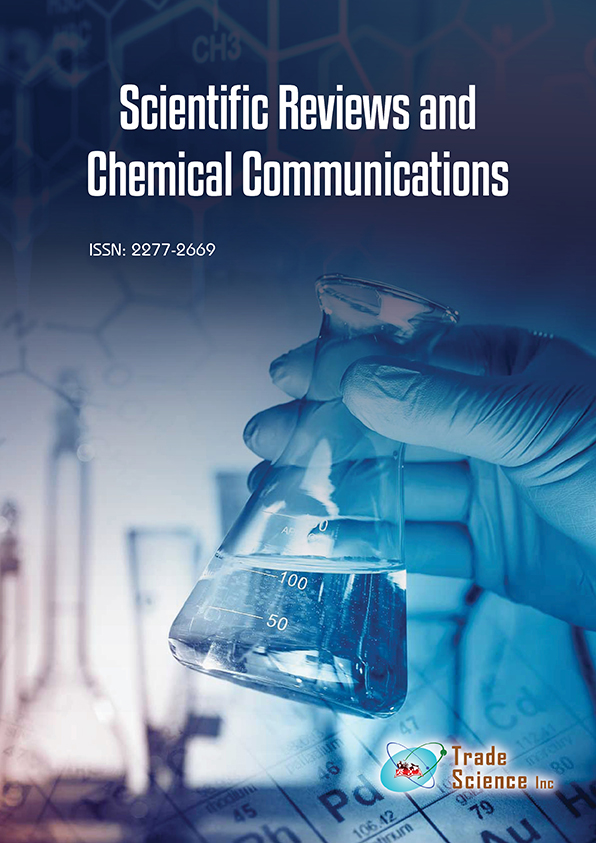Current opinion
, Volume: 11( 2) DOI: 10.37532/2277-2669.11.2.210Advances in the Treatment of Dye Containing Wastewater using Different Systems
Usha Smith*
Department of Chemical Engineering, University of Tehran, Tehran, Iran
*Corresponding Author:Usha Smith Department of Chemical Engineering, University of Tehran, Tehran, Iran Email: smith@rasoicsi.in
Received date: February 15, 2022, Manuscript No. TSSRCC-22-60848; Editor assigned date: February 18, 2022; PreQC No. TSSRCC-22-60848 (PQ); Reviewed date: February 28, 2022, QC No. TSSRCC-22-60848; Revised date: March 08, 2022, Manuscript No. TSSRCC-22-60848 (R); Published date: March 18, 2022, DOI: 10.4172/TSSRCC 2277-2669.210.
Citation: Smith U, Advances in the Treatment of Dye Containing Wastewater using Different Systems. Sci. Revs. Chem. Commun. 11(02):210
Abstract
Plants, as sessile Dye-containing wastewater should be treated effectively using eco-friendly technologies in order to prevent the adverse impacts on the environment and natural water resources. Enzymes can be delivered to the target effluent, including nanoparticles as delivery systems. It also emphasizes the need for current and future research to focus on developing economically feasible and environmentally sustainable wastewater treatment practices. Practically promising for color removal from textile wastewater. Regarding the factors that influence the performance of photocatalytic membrane reactor systems, the role of nanoparticles were discussed by considering their mechanisms of color removal. The limited availability of fresh water is a global crisis. The growing consumption of fresh water by anthropogenic activities has taken its toll on available water resources. Unfortunately, water bodies are still used as sinks for wastewater from domestic and industrial sources. However, in recent times, the need to replenish our water resources has been receiving increasing attention. This has led to the development of strategies to return water to its source in the least toxic form possible, to enable reutilization of water. These strategies and processes may be collectively termed as wastewater treatment. An anthropogenic activity that produces large volumes of concentrated effluent is the process of dyeing. Whether applied to fabric, paper, pulp, leather. The processes involved in dyeing generate effluents that are rich in colorants. The presence of colorants in wastewater and eventually in receiving waters poses a threat to aquatic life forms. This article attempts to explore and evaluate the use of enzymes to degrade or decolorize the dyestuffs in effluents as an alternative to conventional treatment methods. The removal of coloring matter from effluent is a major problem faced by industries. In general, the chemical structure of dyes contains conjugated double bonds and aromatic rings. Many synthetic dyes tend to persist in the environment due to the inherent stability of their molecular structure. Azo dyes for example, have a characteristic azo N₌N linkage which is electron withdrawing in nature. The presence of this linkage decreases the susceptibility of azo dyes to oxidative reactions, thus making them resistant to conventional degradation methods. Complex pollutants that resist degradation and tend to persist in the environment for long durations are considered to be recalcitrant pollutants. Recalcitrance of a given pollutant may sometimes be attributed to unusual substitutions with halides very large molecular size and presence of unusual bonds or highly condensed aromatic rings. The presence of tertiary and quaternary carbon atoms also contributes to recalcitrance. In recent years, the use of living systems such as microorganisms and plants to degrade recalcitrant pollutants is gaining importance as a viable alternative to existing physio-chemical removal methods. Stringent government policies regarding permitted levels of pollutants, high costs of specialized chemical treatments for pollutant removal and the fact that some of these treatments create additional solid waste has led to the development of many effective, yet simple biological methods. These treatment processes can be collectively categorized under bioremediation of wastewater. Enzymes are versatile and may be delivered to the target effluent in different ways.
Methods for Degradation of Recalcitrant Pollutants
Contemporary delivery system selected, must be well suited to the purpose, simple, efficient and cost effective. However, special attention has to be given to ensure that the activity of the enzyme is not adversely affected due to the mode of delivery. The use of entire rooted plantlets of Typhonium flabelliform to decolorize synthetic wastewater has been tested at the laboratory scale. The enzymes such as peroxidases, secreted by the roots of the plant bring about the degradation of dyes like malachite green, methyl orange and brilliant blue. Such methods of effluent treatment are economically feasible and offer simpler alternatives to existing methods for degradation of recalcitrant pollutants. However, adding biological material to an effluent will increase of the effluent. Also, if there is an uncontrolled growth of microorganisms on the biological material, the effluent could require an additional disinfection treatment before it is released into a water body. Nanotechnology is fast gaining importance in wastewater treatment. It can offer more effective methods to decontaminate xenobiotics in the environment. Nanoparticles have a very large surface area to volume ratio, high reactivity and sequestration properties all of which have immense potential for use in wastewater treatment. Remediation of waste streams containing dyestuffs, cleaning up of heavy metals from contaminated soil and water by absorption and sequestration are possible using nanoparticles. The use of nanoparticles in reactive remediation technology is of great interest to wastewater treatment, since it involves the complete degradation of contaminants to harmless products such as carbon dioxide and water. Another type of novel nanoparticle is Nano sponges. These are materials containing microscopic particles with Nano-sized cavities. These particles can encapsulate or can be embedded with many types of substances and are capable of transporting them through an aqueous medium. Nano sponges with complexes consisting of Nano polymers and enzymes have been synthesized recently. These Nano sponges are created by embedding the enzyme in a polymer matrix. Novel nanoparticles such as these could be synthesized using enzymes such as peroxidase and laccase. Such Nano sponges could find application in remediation of wash streams from dyeing and textile processing industries. At present, the utilization of Nano polymers in wastewater is primarily in the removal of heavy metals. As compared to the conventional methods used to treat complex and recalcitrant pollutants in industrial effluent, the use of nanoparticles offers relatively inexpensive alternative treatments. However, nanoparticles can remain in suspension for extended periods of time and this fact raises concerns regarding their toxicity. The toxic effects of nanoparticles on aquatic organisms are still being evaluated. A fair evaluation of the toxic effects of nanoparticles and of the consequences of their persistence in the environment will enable the development of effective and sustainable effluent treatment strategies, which will include the judicious use of nanoparticles.
Advantages of Enzymatic Wastewater Treatment
Enzymes have been employed in numerous fields primarily for their immense catalytic potential. In wastewater treatment, enzymes can be utilized to develop remediation processes that are environmentally less aggressive than conventional techniques. Their versatility and efficiency even in mild reaction conditions gives them an advantage over the conventional physio-chemical treatment methods. The biological origin of enzymes reduces their adverse impact on the environment thereby making enzymatic wastewater treatment an ecologically sustainable technique. Despite the advantages of enzymatic wastewater treatment, the major limitation in the use of enzymes is their prohibitive cost. Currently, effluent treatment using enzymes on a large scale is not economically viable. However, if maximum reusability of enzymes is achieved through the use of standardized immobilization procedures, the running cost can be lowered considerably. The confluence of nanoscience and enzyme technology has resulted in an upcoming interdisciplinary approach to wastewater treatment. Such innovative applications of enzymes can enable the utilization of these biocatalysts to their maximum potential.

